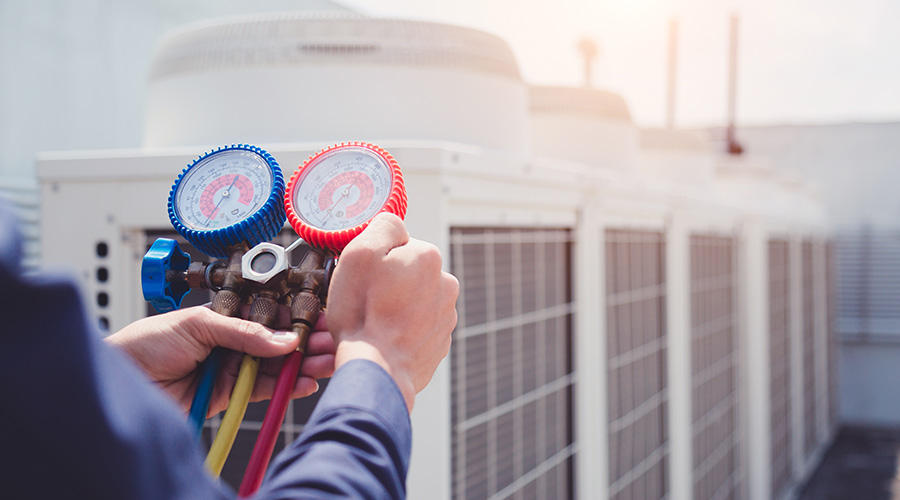HVAC Trends: What Facility Managers Need to Know
HVAC leaders discuss industry trends and what facility managers need to know.
The AHR Expo annually brings together leaders and manufacturers in the HVAC industry. The international show is an opportunity for leaders to educate about the latest in regulations and gives HVAC suppliers a platform to show off their latest products and systems for consumers such as facility managers to consider when they are upgrading their systems.
While walking the expo halls and sitting in on educational sessions, conversations with manufacturers and industry leaders often focused on three trends that facility managers should know about – the electrification of buildings, the transitioning to more environmentally friendly refrigerants and the money available from the federal government to institutional and commercial facilities to upgrade their HVAC systems.
Electrification
As communities and institutions continue to establish decarbonization goals, the push to electrify buildings and HVAC components has increased. States, mostly located on the east and west coasts, are leading the push to electrify.
“We’re looking to design new buildings so they are much more efficient in terms of energy use, but new buildings only account for about 3 percent of the building stock,” says ASHRAE President Farooq Mehboob, meaning a vast majority of the institutional and commercial buildings currently in use will eventually need to be retrofitted to meet net-zero goals.
A year ago, Washington became the first state in the U.S. to incorporate electrification mandates into its building codes and require all-electric space and water heating in new commercial buildings. Other states have since jumped onboard announcing similar mandates.
“Electrification in the public’s mind is only really a couple of years old, and most of that time was during the pandemic,” says Matt Rusteika, the director of market transformation for the Building Decarbonization Coalition. “We’re talking about something that most people experience as being kind of out of left field.”
One of the products most associated with the push to electrification during conversations were heat pumps, a technology that has been around for a long time. As manufacturers further embrace the electric age, they are finding more ways to utilize the technology to match the needs of different kinds of facilities.
“We’ve seen a lot of expansion in terms of the products that are available and the companies that are focusing more heavily on heat pumps as a key product for them,” Rusteika says. “The technology itself is 150 years old. No one would live in Florida without heat pumps. This is not like a solar (transition) or something like that. It’s a genuinely new or new-ish thing. We’re talking about a subtler shift.”
Technology changes for heat pumps over the years provide an opportunity for managers to incorporate them into any plans they might have to convert their building systems to electric.
“One of the big myths about this is this long history of heat pumps not working in cold weather, but that’s really going away fast now,” says Mark Frankel, principal of policy and innovation at Ecotope, Inc., and the chair of ASHRAE’s TFBD Heat Pump Working Group. “The systems working in cold temperatures gives us a lot more flexibility to use them in commercial buildings and other applications in colder parts of the country. A lot of simple commercial buildings, a lot of those are moving to heat pump technology now because the outdoor unit can run outside on the roof, and not have to worry about the temperature delivery.”
Managers who are unfamiliar with the benefits of electrification or the process of transitioning their buildings are encouraged to speak with their suppliers to see what’s available to them in the space.
“Suppliers are going to be the best judge of what’s available and what isn’t,” Rusteika says. “There’s going to be a lot for everyone to learn, about what cases are easier versus harder to electrify. The market’s moving so fast that maybe the last time facilities made a major upgrade, it may have been completely different to what it is today. Familiarize yourself with the products, what they cost, and how they might interact with the existing systems in your building.”
No matter where facilities are in the electrification process, it remains important that managers proceed carefully into some unchartered waters.
“I would think about building systems efficiency, which includes the envelope and operations and storage and heat pump technology, etc.,” Frankel says. “It’s not just, ‘This appliance is coming in with this efficiency and we’re going to plug it into our old system.’ When you size (system equipment) you want to think about the combination of more efficiency upgrades to the envelope and a smaller mechanical system and your cost distribution, not just a replacement. That’s a big and fairly common issue that’s faced in retrofits.”
Dave Lubach is the executive editor for the facility market team. He has eight years of experience writing for the facility management industry team.
Related Topics:













